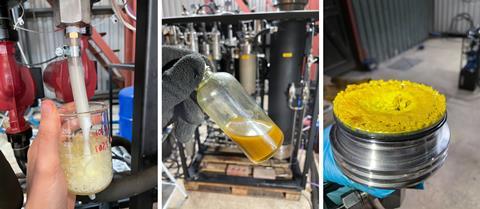London-based duo wants this powerful technique to be cheaper and more widely accessible
Supercritical fluid extraction (SFE) was originally developed in the 1970s to decaffeinate green coffee beans. Now it is used in all sorts of applications that require separating components from complex mixtures: producing hop extracts for beer, for example, or extracting fragrances and pharmaceutical products from plants. But for all its applications, it is also unattainable for most companies.

Supercritical fluid – the state of matter resulting when a gas is compressed above its critical temperature and pressure – has the solvating power of a liquid and the diffusivity of a gas. Fluids such as supercritical carbon dioxide are versatile, green solvents that, unlike other forms of extraction, separate essences without degradation or impurities.
This high quality comes at a cost, says Alex Novitskiy, co-founder and chief executive of London, UK-based Nova Extraction. ‘Supercritical extraction equipment is usually so expensive, even the top processors in the world try to outsource extraction, rather than own the equipment.’

When Novitskiy’s colleague and co-founder, Sergey Soshin, was working on his PhD in engineering at the Kazan National Research Technological University in Russia, he found himself in need of extraction equipment. Without the means to afford it, he decided to design and build it from scratch – capitalising on ten years’ experience in the automotive industry. Nova was founded to take Soshin’s meticulously re-engineered equipment to market, in the belief that it could break barriers of entry for smaller companies.
The underlying process of Nova’s equipment remains the same as the conventional process. Liquid CO2 is pressurised, then heated up. It enters an extraction vessel packed with the raw material of choice and, thanks to its high diffusivity, easily dissolves target components.
SFE equipment can precisely control which components in a complex matrix are extracted and which ones are left behind. It does this by exactly regulating parameters such as temperature, pressure, flow rates and processing time. Once the target components are dissolved, the flow enters a separation vessel where pressure is reduced and the target components precipitate. The CO2 is usually recovered and reused.
The differences in Soshin’s equipment comes down to technical details. ‘Unlike any other company in SFE equipment, Sergey started designing it from a physics point of view,’ Novitskiy says. ‘We designed equipment for the whole process with the goal to improve the efficiency and decrease the cost and hence share savings with our clients.’ On average, he says, for each dollar invested, Nova’s equipment will process eight times more material than a classic laboratory system.
High performance pumps, for example, translate directly into how many batches the machine can perform in a day and make it more efficient and economical to run. Everything is that bit more efficient: from the CO2 recirculation technology to the preheaters that avoid the gas freezing at separation.
Mobile and adaptable
In their quest to make extraction technology more accessible, Novitskiy and Soshin are working on a pay-as-you-go rental model that could open doors for small companies and industries with ad hoc extraction requirements. ‘It’s not something that’s been done before,’ says Novitskiy. ‘On average, it still costs more than a million dollars to build an industrial size unit. And it takes time, whereas a rental model means immediate access.’
A unique advantage for the rental business model, he says, is the option to work off-grid – even in remote locations with poor infrastructure, without the need for external electricity or water supplies. ‘For example, equipment mounted in a 20-foot container can be shipped to almost any location in the world for in-situ processing, instead of shipping raw material to Europe,’ he explains. ‘This saves on the transport costs and cuts carbon emissions.’
The idea depends on making the equipment easy to service and operate so clients don’t have to rely on in-house staff with prior knowledge of the complicated technology. It also needs to be flexible enough to cater to a range of industries, which takes a wide range of extraction and separation parameters, explains Novitskiy.
While Novitskiy is confident that the technology is up to the task, the pair have little data on how their technology compares to conventional SFE equipment in terms of its selectivity, optimisation and speed. Ironically, this comes back to the unaffordability of existing equipment. ‘Since we do not possess any of the equipment of the competition it is hard to make a direct comparison,’ says Novitskiy, ‘but two of our clients who both own a competitor’s system did compare it to our very early prototype and found ours to be much faster.’
As it stands, their equipment mostly serves the fragrance industry. The low operating temperature of CO2 extraction lends itself to protecting fragile fragrances, such as rose or lavender, for high-end perfumes. Nova also works with hemp growers to extract cannabinoid oil for health benefits. And Novitskiy is hoping to soon start experimenting with food waste. ’Waste from Ribena [blackcurrant squash drink], for instance, is full of natural colourants and they can be extracted with CO2 and then be used in the food industry,’ he says.
Nova Extraction
Location: London, UK
Size of team: Five
Origin: Start-up
Funding: Financed and owned by founders












No comments yet